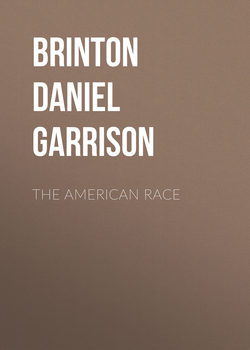Читать книгу The American Race - Daniel G. (Daniel Garrison) Brinton, Brinton Daniel Garrison - Страница 14
NORTH AMERICAN TRIBES
II. THE NORTH PACIFIC GROUP
Оглавление1. THE NORTHWEST COAST AND CALIFORNIAN TRIBES
The lofty chains of the Rocky Mountains extend from north to south, leaving a narrow coast line seamed with deep and fertile valleys along the Pacific from Mt. St. Elias to the Gulf of California. In spite of its great extent in latitude—from the 30th to the 60th degree—there is less difference in climate than one would suppose from analogy in any other part of the world. The warm ocean current which bathes the northern coast mitigates the cold of the winter to such an extent that the isothermal lines on the Pacific are fifteen degrees of latitude more northerly than on the Atlantic border of the continent.
A few of the eastern stocks, the Athabascan and the Shoshonian, have sent out colonies who have settled on the banks of the Pacific; but as a rule the tribes of the western coast are not connected with any east of the mountains. What is more singular, although they differ surprisingly among themselves in language, they have marked anthropologic similarities, physical and psychical. Virchow118 has emphasized the fact that the skulls from the northern point of Vancouver’s Island reveal an unmistakable analogy to those from the southern coast of California; and this is to a degree true of many intermediate points. Not that the crania have the same indices. On the contrary, they present great and constant differences within the same tribe;119 but these differences are analogous one to the other, and on fixed lines.
There are many other physical similarities which mark the Pacific Indians and contrast them with those east of the mountains. The eyes are less oblique, the nose flatter, the lips fuller, the chin more pointed, the face wider. There is more hair on the face and in the axilla, and the difference between the sexes is much more obvious.120
The mental character is also in contrast. The Pacific tribes are more quiet, submissive and docile; they have less courage, and less of that untamable independence which is so constant a feature in the history of the Algonkins and Iroquois.
Beginning at the sixtieth degree of north latitude and extending to the fifty-fifth, are the Tlinkit or Kolosch. They dwell on the coast of Alaska and the adjacent islands. Physically they are a strong and often tall people, light in color, with black or slightly reddish hair, eyes horizontal, nose aquiline. The Russians spoke of them as the most intelligent tribe they encountered on the coast. They certainly seem to have developed an uncommon appreciation of property, which is supposed to be a sign of a high order of intellect. Thus they have a gentile system with descent in the female line, but their aristocracy and the selection of their chiefs are entirely on a property basis. The richest obtain the highest places.
The Tlinkit villages are permanent, the houses solidly constructed of wood, sometimes with the additional protection of a palisade. The carving and painting upon them are elaborate, the subjects being caricatures of faces, men, and animal forms. The chiefs erect at one side of their doors carved and painted “totem posts,” some of which are nearly fifty feet high. These are also found among the Haidahs and Tshimshians to the south. The arts are correspondingly developed. Seaworthy canoes are hewn from the trunks of the red cedar, hides are dressed and the leather worked into a variety of articles; lamps, mortars and utensils were chipped or ground out of stone, and they are handy in beating out ornaments of silver and copper. The Tlinkits have always been active merchants, and when the first navigators visited their villages in 1741, they were surprised to find them in possession of iron knives and other articles obtained by trade over East Cape or from the south. The usual currency were the dentalium shells found along the coast. One of the staple articles of trade were slaves, a custom not in existence on the Atlantic. They were bought from the neighboring tribes, and treated with great cruelty.
Tlinkit mythology is rich, having a coherent creation and deluge myth, the principal figure in which is Jelchs, the raven. He is the Promethean fire-bringer, and sets free the sun, moon and stars from their prisons. The religious rites are in the hands of priests (shamans), who as usual exert a great and injurious influence.121
The Haidahs, who dwell on Queen Charlotte Islands and Prince of Wales Archipelago, are probably a distant branch of the Tlinkit, though the affinity has not been clearly established, so they are officially classed as the Skittagetan stock, from the Skidegate dialect of the coast. In culture and appearance they resemble the Tlinkits, having similar mechanical skill. Their canoes and their intricate carvings, especially totem-posts and pipes of black slate, are celebrated products of the northwest coast.
The above and other tribes of British Columbia and Washington, the Tshimshian, the Kwakiutl, the Nootka, Salish, Chinook, etc., are so much alike physically that Dr. Boas, who has carried out the most recent and thorough examination of them, observes that no physical distinctions can be drawn between them.122
118
R. Virchow, Verhand. der Berliner Gesell. für Anthropologie, 1889, s. 400.
119
Dr. Franz Boas, “Fourth Report on the Tribes of the North West Coast,” in Proceed. Brit. Assoc. Adv. Science, 1887.
120
Dr. J. L. Le Conte, “On the Distinctive Characteristics of the Indians of California,” in Trans. of the Amer. Assoc. for the Adv. of Science, 1852, p. 379.
121
Dr. Aurel Krause, Die Tlinkit Indianer. (Jena, 1885.)
122
See the various reports of Dr. Boas to the British Association for the Advancement of Science, and the papers of Messrs. Tolmie and Dawson, published by the Canadian government.
